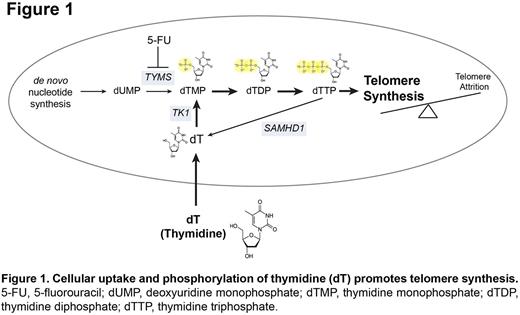Abstract

Inherited mutations in telomere maintenance genes are associated with short telomeres and can cause severe diseases including the congenital bone marrow failure syndrome dyskeratosis congenita, liver cirrhosis, and pulmonary fibrosis, collectively referred to as telomere biology disorders (TBDs). Current approaches to treat TBDs rely on bone marrow and organ transplantation, and patients face poor prognoses. New systemic therapies to promote telomere elongation and treat TBDs throughout the body are needed. Here, we performed the first genome-wide CRISPR/Cas9 functional telomere length screen using flow cytometry-FISH (flow-FISH) in human cells to identify novel telomere maintenance pathways that might be manipulated for therapeutic benefit. Validating our approach, we found guide RNAs targeting positive (e.g. TERT) and negative (e.g. POT1 and TRF1) regulators of telomere length enriched in sorted cells with short and long telomeres, respectively. Unbiased pathway analysis of screening hits demonstrated nucleotide metabolism genes to be highly associated with telomere length, consistent with recent genome-wide association studies, and which in follow-up screening we narrowed down to multiple control points specifically along the thymidine (dT) nucleotide metabolism pathway. Targeted genetic disruption using CRISPR/Cas9 revealed that decreasing dT nucleotide salvage by thymidine kinase (TK1) or de novo production by thymidylate synthase (TYMS) reduced telomere length, whereas inactivation of the dNTPase-encoding gene SAMHD1 lengthened telomeres. We next asked whether nucleotide precursor manipulation could alter telomere length dynamics. Remarkably, we found supplementation with dT nucleoside alone drove rapid telomere elongation in human cells (Figure 1). Telomere elongation after dT treatment required conversion to thymidine monophosphate (dTMP) by TK1, was telomerase dependent, and could be achieved at doses that did not inhibit cell cycle progression. In cells with TYMS deletion or after treatment with the TYMS inhibitor 5-fluorouracil, dT supplementation was sufficient to bypass the de novo nucleotide synthesis defect and promoted robust telomere elongation. SAMHD1 overexpression blunted the degree of telomere elongation from dT treatment in a manner requiring its dNTPase activity, suggesting that telomere length control occurs at the level of dTTP in human cells. To assess whether nucleotide manipulation could overcome the genetic causes of telomere insufficiency which drive TBDs, we tested dT on induced pluripotent stem cell (iPSC) lines derived from patients harboring mutations in a spectrum of TBD-associated genes including DKC1, TERC, TERT, TINF2, RTEL1, and PARN. We found dT supplementation or inhibition of SAMHD1 drove robust telomere elongation in patient derived iPSCs spanning genotypes that cause telomere maintenance defects both by telomerase-dependent and telomerase-independent mechanisms. In preliminary experiments using primary human hematopoietic stem and progenitor cells, dT treatment resulted in telomere elongation in vitro, pointing to a potential treatment for TBD-associated bone marrow failure. Collectively, our results demonstrate a critical role of thymidine nucleotide metabolism in regulating human telomere length. Based on our findings, we propose there may be a therapeutic window to modulate telomere length by manipulating dT metabolism in patients with TBDs.
Disclosures
Agarwal:Astellas Pharma: Research Funding; Rejuveron Telomere Therapeutics: Consultancy, Current holder of stock options in a privately-held company, Research Funding; Cimeio Therapeutics: Consultancy, Current holder of stock options in a privately-held company, Membership on an entity's Board of Directors or advisory committees.
Author notes
 This icon denotes a clinically relevant abstract
This icon denotes a clinically relevant abstract
Asterisk with author names denotes non-ASH members.


This feature is available to Subscribers Only
Sign In or Create an Account Close Modal